Step 4: To identify the purpose(s) of each bit of content.
Develop a content marketing matrix that identifies the purpose of each bit of content. The purpose will be determined by who your target audience is.
Establishing your objectives first will help to formulate your content. For example, is the content serving to provide entertainment, inspiration, education or impetus to take action or purchase?
Content Purposes.
- Entertain – engaging content that creates awareness and interest – the first stage in the consumer buying process.
- Inspire – content that succeeds in emotive response, often best used later in the buying process. The goal is to make the potential customer ‘feel’ something from relatable content, that ultimately drives purchase.
- Educate – providing thought leadership content helps to position your business as a trusted and reliable source, raising or reinforcing consumer opinion of your product/service. Educational content should provide customers with new information either about your own products and services, or a relatable topic, and should be well-researched to provide significant value.
- Convince/Purchase – the last stage of the buyer’s journey, should focus on content that already understands your target audience needs and wants. The aim is to satisfy these needs with accessible and influential content.
Step 5: Use the grid to plot the different content types (formats).
This will help your company to figure out what works best and why. You can then edit the grid as part of a test, track and measure process to see what content is working best at what stage and for your specific target audience.
Each format falls in a different place on the grid and some even fall in multiple places on the grid. For example, videos can both educate and entertain (depending on nature of the content of said video) but may not convince.
Step 6: Expand your pool of content marketing assets.
Ensure you have a range of content that can be used to take people through the sales funnel and enough variety of content formats to reach people in different ways.
Measuring the impact of your content marketing mix.
Establish which KPI’s you wish to track so that you can measure the effects of your content marketing strategy. Typical KPI’s include: unique page visits, downloads, time spent on page, links, shares, comments, interactions. For paid campaign activity, metrics would include cost per click, cost per lead, lead generation, conversion rates, influencers, followers, subscribers and channel growth.
It is only through tracking, monitoring and measuring your content marketing efforts that you start to develop a full understanding of the success of your efforts.
